Deities Treated as Playthings
The Hindu Gods & Goddesses are not only dishonoured when their pictures are
discarded or neglected, but also they are dishonoured when they are treated as playthings. Very
often the idols and pictures of the deities are used in the way one likes as if they are playthings,
causing irreparable damage to the dignity of the deities and making a mockery of their divinity.
(1) It is common to find Lord Ganesh being portrayed in different characters in some
of the puja pandals during Ganeshotsava. In the past Lord Ganesh has been
depicted in his idols as a soldier holding a machine-gun, as a cricketer waving the
bat, as a judge listening a case in the court, as a film star riding a motorbike and
as a traffic police controlling the traffic - all complete with the required
characteristic dress, uniform or costume suitable for the roles. Not only this, in
order to make unique Ganesh idols various odd materials are used such as pieces
of mirrors, matchsticks, shells, rudrakshas, pulses, seeds, coconuts, coins, buttons,
bells, utensils, baskets, rice, laddus and panipuris etc. It seems people are taking
Lord Ganesh in a casual manner and are playing with the dignity of the deity by
representing him in distorted manner in the name of creativity, even overlooking
the mentions in the Hindu religious texts. These distorted idols, being highlighted
in the media, become crowd-pullers. As such the spiritual environment of the
Ganeshotsava is diluted and an atmosphere of entertainment is created.
(2) It is funny but serious that the workers of some political parties of India have
13
crossed all the limits of flattery as it appears from the posters prepared by them.
In order to please their leaders they have gone to the extent of depicting them as
all-powerful Hindu Gods & Goddesses in their posters. The workers of a
particular political party have depicted their supreme leader as Goddess Durga,
while their counterparts of another political party have depicted their top ranking
leaders as Annapurna, Brahma, Vishnu and Maheshwar. These posters invited lots
of reactions from the public. However, their leaders expressed their displeasure
over these incidents. Actually the pictures of the deities, used in these posters,
have their faces replaced by the faces of political leaders along with some
additions and modifications by using modern techniques. This is a clear case of
distortion of the pictures of Hindu Gods & Goddesses. It seems, these people do
not have any fear or hesitation in doing whatever they like with the deities
(3) There have been cases of disgraceful representations of Hindu deities in some
advertisements and greetings. In an advertisement, which appeared in
newspapers, a renowned watch company depicted Goddess Durga as holding ten
pieces of wrist watches in her ten hands in place of her divine weapons, thus
making a mockery of the deity. In a Diwali greeting, published by a leading English
newspaper, the message 'The Triumph of Good over Evil' was depicted as Lord
Rama, placed on the label of a half-opened match- box, was shooting a burning
matchstick from his bow at demon Ravana, placed on the label of a firework.
Here the dignity of Lord Rama has been lowered down by placing him on the
label of a matchbox and by replacing his divine arrow with a mere matchstick. Also
the very placing of Lord Rama on the label of a matchbox indirectly encourages
the evil practice of placing Hindu deities on packing materials of consumer
products. Yet in another advertisement, published on the cover page of a leading
fortnightly, Mahendra Singh Dhoni, the captain of Indian Cricket Team, has been
depicted in the incarnation of Lord Vishnu, holding eight commercial products in
his eight hands out of which one is a shoe. Below him are the words 'God of Big
Deals'. It is a clear case of insulting Lord Vishnu and this has hurt the sentiments
of the Hindus. There have been protests in many places against this
advertisement. A Hindu organization has filed a suit against Mr. Dhoni, the
publisher, the printer and the editor of this fortnightly in a court at New Delhi. This
is how people are playing with the dignity of Hindu Gods & Goddesses and are
using the technical expertise in an irresponsible manner.
(4) There is nothing new in taking Gods & Goddesses as subject matter of art. In the
past the Hindu deities have been glorified in the traditional sculptures and
paintings of India. But in the modern paintings of India, Hindu deities are very
often represented in a disgraceful manner. Some modern artists in India
deliberately distort the deities in their paintings in the name of freedom of
expression, ignoring the religious sentiments of the Hindus. For these artists,
mentions about the deities in the Hindu religious texts have little meaning. In the
recent past there have been protests from Hindu organizations against obscene
and distorted representations of Hindu deities by a renowned artist. In fact,
nobody should be allowed to play with the dignity of Hindu deities in paintings. It
should be remembered that enjoying freedom, without accepting social
responsibilities, is nothing but autocracy.
14
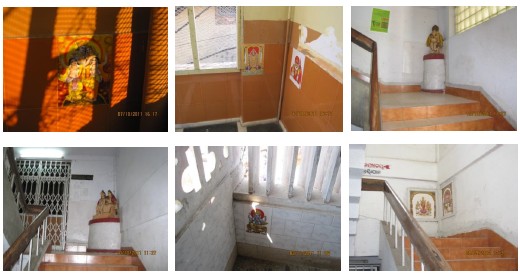
(5) It is unfortunate that the idols and pictures of Hindu deities on glazed tiles are
being installed and fixed at the turns of staircases leading to upstairs of many
Government offices and Nationalized Banks, not as an expression of devotion to
God, but as a shrewd technique to scare the betel-chewers from spitting on the
walls. The Government officers have not only placed the Hindu deities alone at
unsuitable places, but also have treated the deities in an undignified manner by
employing them as watchmen to keep a vigil on wrong-doers. The said officers,
instead of making people aware of the law or taking action against the offenders,
have preferred to create fear in the minds of the people of committing sin if they
spit on or near the deities, which is not only wrong but also is an anti-secular act.
May be inspired by this arrangement in the offices and banks, some people keep
pictures of the deities at the turns of the staircases of multi-storeyed apartments
to check the betel-chewing residents and guests from spitting on the walls. What
is more disturbing is the fact that some people fix glazed tiles, bearing pictures of
different deities, on the lower portion of the outer walls of their houses in order
to discourage the passersby from urinating against their walls.
DEITIES POSTED AT THE TURNS OF STAIRCASES
(6) Far away from calm, clean and beautiful surroundings amidst noisy, polluted and
unpleasant surroundings are numerous small temples, situated at the sides of
busy roads beside open drains in the towns and cities. These temples are tactfully
built on Government land in order to protect a group of temporary shops, built
afterwards beside the temples on encroached land, from being demolished by the
authority. Mostly the idols of Lord Hanuman and Mother Goddesses are placed
inside these temples, which are not at all suitable to them. In fact, all ancient
temples were built in excellent natural surroundings, which incidentally turned
into congested areas after centuries. But at present, the idols of the deities are
treated as mere dolls and are placed wherever one likes without considering the
dignity of deities.
15
(7) In the urban areas the idols of different deities are very often found being kept in
the open, on the outer portion of attractive temples, gates and buildings as an
act of beautification. Sometimes very tall idols of deities are found inside parks in
the cities. These deities are not only exposed to noise, but also are exposed to sun,
rain, wind and cold like the deities, placed on the signboards and banners. Unlike
the idols inside the temples, these idols in the open are not worshipped. In fact,
once in a year they are cleaned and washed by the rain only. May be once in a
few years these idols are coloured. The idols of Hindu deities should be taken
seriously and they should be well- attended and worshipped wherever they are.
They should not be used for pleasure and beautification only
(8) Some men and even boys are found moving in the market place, bus stands and
railway stations etc. holding plates in their hands and begging. They are no
ordinary beggars but are self-styled devotees as they use to carry the idols,
pictures of deities or their representations on the begging plates with some
flowers and a couple of burning incense sticks. They walk from person to person,
keep the deities facing them and wait till they give some coins on the plate or
refuse to give. Generally people offer some coins out of fear for the deities. This
is an old practice, adopted by some people to earn money without much effort. In
fact, people go to temples to pay their obeisance to the deities. It is not the other
way round when deities are made to come to the people to receive their obeisance.
By keeping the deities on the begging plates and approaching people for alms the
dignity of the deities is damaged.
(9) It is a common sight during the holy month of Shravana to see groups of saffron-
clad young devotees, with pictures of Lord Shiva printed on their T-shirts,
marching towards distant Shiva temples, shouting slogans in praise of Lord Shiva,
carrying holy water from rivers. It is quite obvious that due to long distant march
the pictures of Lord Shiva on the T-shirts take a bath with the sweat of the
devotees much before the Shiva Lingam at the temples take a bath with holy
water, poured by these devotees, better known as kavadias. Though there is no hard
and fast rule that a devotee, pouring holy water on Shiva Lingam during Shravana,
has to wear saffron dresses, these days it has become a fashion among the young
devotees to wear saffron dress, complete with pictures of Lord Shiva on the T-
shirts along with other accessories, as an outward display of their devotion to Lord
Shiva, thanks to the innovative ideas of some opportunistic businessmen.
Nowadays fahionable T-shirts with colourful pictures of different Hindu deities
are available in the market. Popular TV stars are found wearing such shirts in TV
serials. It is felt that the sanctity of the deities cannot be maintained if they are
depicted on dress materials. In fact, the deities do not get dignified if their
pictures are used as fashionable motifs on dress materials or on ladies' handbags
and gents' side bags, which are available nowadays. These are how people play
with the Hindu deities in India.
16
Hindu Deities Insulted in the West
It is no secret that Hindu Gods & Goddesses in India are dishonoured when their
pictures, placed on packing & advertising materials, newspapers and many other objects, are
later on discarded, neglected or ignored. It is well-known that the Hindu deities are often
represented in undignified manners at puja pandals during Ganeshotave, in political posters,
in advertisements and in modern paintings. Nevertheless, it is also known that the Hindu
deities are dishonoured when they are placed at unsuitable places without proper
consideration.
It appears, some notorious elements in the West, being encouraged by the above
incidents in India, have ventured to play with the honour and dignity of the Hindu deities but
with an intention to insult Hindu deities and hurt the Hindu sentiments. Some newspaper
reports on such incidents, which took place in the West, are giving below:-
(1) The Times of India (11-06-2004) - Roberto Cavalli, an Italian designer depicted
Lord Rama at strategic places of bikinis. Later on, the designer apologized due
to protest by National Council of Hindu Temples of Britain.
x x x Cavalli was just the latest of a long line of European and American
commercial enterprises to fall foul of Hindu sentiments. Till now, toilet seat
covers, boxes of tissues, shoes, sandals and finger puppets have all been tracked
down as bearing "offensive" images, variously Lord Krishna, Ram, Saraswati and
so on. x x x
(2) Sambad 'Odia' (20-05-2005) - Very often it is observed that different companies
and business establishments of Western countries are making their products
branded in the names of Hindu Gods & Goddesses. Products such as slippers,
shocks, petticoats, blouses, dustbins and even toilet basins are depicted with
Hindu deities and are send to the market with the names of Hindu deities only
with an aim to create demand by increasing interest of the customers. x x x
Lost Coast Breweries, a liquor producing company of California, USA, had
placed the picture of Lord Ganesh on the label of 'Indica Ganesh' brand of beer
bottle. In this picture Lord Ganesh was depicted as holding a bottle of beer in one
hand and another bottle in his trunk. Due to the protest of local Hindus the
company withdrew this brand of beer from the wine shops and bars.
(3) Sambad 'Odia' (16-02-2006) - Very often strange things are seen in the world of
advertisements. If sometimes the picture of Lord Rama placed on toilet papers
enrage the devotees, then at times the tricolor placed on the dress of a model hurts
the sentiments of the countrymen. x x x
Balon Oriental Disco Bar of Athens, Greece has depicted Goddess Durga as
holding eight bottles of liquor in her eight hands on the poster, while advertising
for a brand of whisky. The Hindus, the world over, particularly the General
Secretary, National Council of Hindu Temples, USA have condemned this act.
(4) Sambad 'Odia' (30-10-2006) - The Hindu Gods & Goddesses have to face a lot of
humiliation in the Western countries. If sometimes the picture of Hindu deities are
placed on liquor bottles, than at times on undergarments. There is no double
17
opinion on the fact that Hindu deities are attractive. But it is natural for the
Hindus to be angered when the deities are used for decoration of houses rather
than for faith. The picture and idol of Goddess Laxmi and Lord Ganesh have
been used for interior decoration of a night club in London. After knowing this
the Hindu organizations of entire London protested against the night club. In
spite of all these, the idol and picture of the deities were not removed from the
place. The owner of the club Mr. P…B… wants to have a talk with the Hindu
organizations. x x x
(5) Dharitri 'Odia' (10-12-2006) - A liquor company named "Absolute Vodka" has
released the advertisement for its Vodka in its website, www.absoluad.com,
where Lord Ganesh was depicted holding a bottle of liquor in place of a Laddu
(Sweet) in his hand. This has hurt the sentiments of the Hindus. They have
expressed grave concern over this advertisement.
(6) Dhartri 'Odia' (15-12-2007) - A dress company of USA has released in its website,
www.cafepress.com, pictures of undergarments on which Hindu deities such
as Jagannath, Balabhadra & Subhadra, Rama, Ganesh and Durga etc were depicted.
(7) Sakal Times (16-05-2012) - An American brewery company placed Goddess Kali
in the advertisement for launching 'Kali-Ma' brand of beer. The Rajya Sabha
members protested on this issue at the Indian Parliament. The concerned
company apologized for naming the beer after Goddess Kali and postponed
launching the beer.
x x x Earlier also picture of Goddess Laxmi was displayed in a toilet, picture of
God was put on bra, Lord Ganesh was displayed as a sex object in a talk show x x
x a store in US had pictures of Ganesh on slippers x x x
18
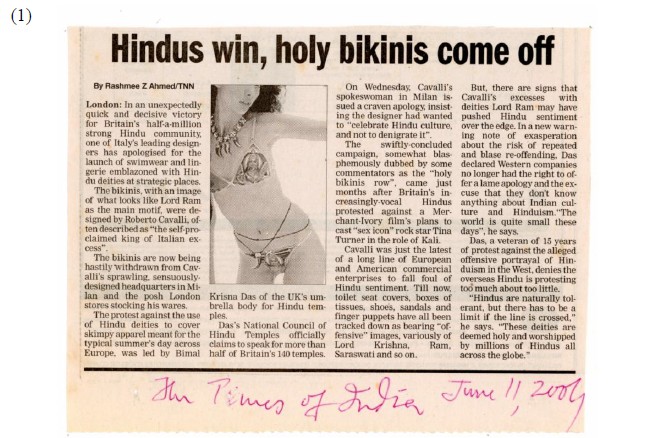
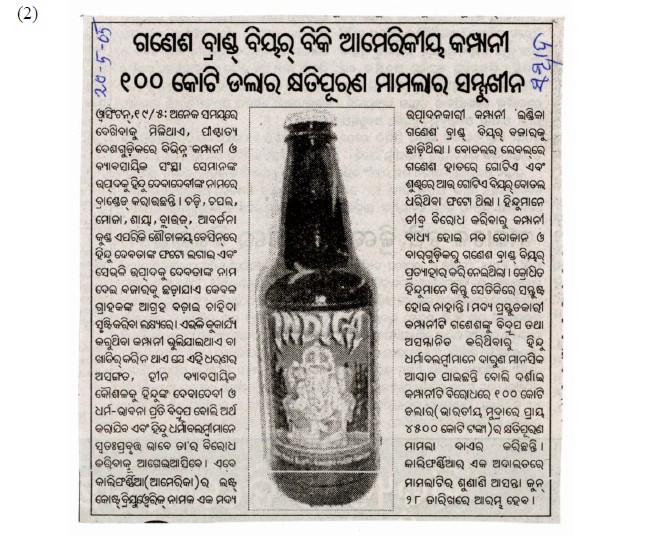
19
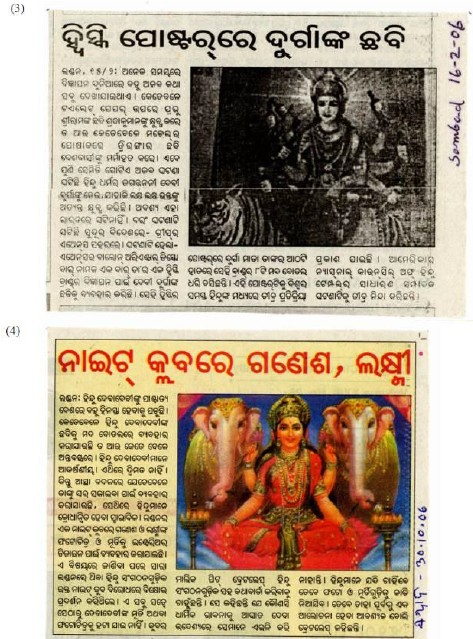
20
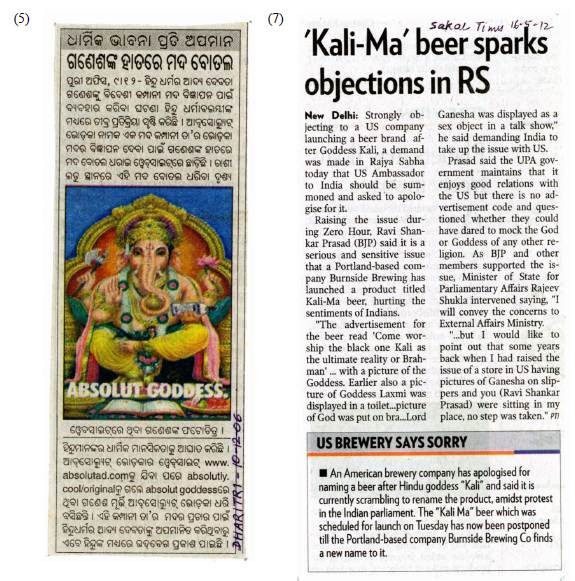
(Sl. No. 6 on next page)
21
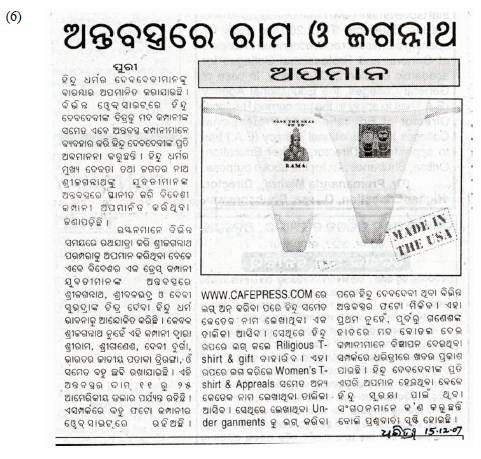
Hindu Deities Dishonoured by Western Models in India
It is indeed painful and unfortunate as Hindu deities are often humiliated and insulted
in the West when their pictures were placed on objects like toilet seat covers, toilet papers,
shoes, bras, underwear, wine bottles and dustbins etc. and when they were depicted on labels
and posters in an undignified manner, such as holding bottles of liquor. But it is indeed
surprising when Western models in India are promoting dresses, depicting Hindu deities.
There are reports in the newspapers regarding such incidents.
(1) Sambad 'Odia' (25-02-2005) - A British model was found wearing a ghaghra (a dress
worn from waist to feet by ladies) on which Lord Ganesh was prominently depicted.
As a result there was protest against this incident at Bhopal.
(2) Samaj 'Odia' (11-05-2011) - On the eve of Australian Fashion Week celebration at
Rourkela, model Lisa Blue exhibited a bikini (swim suit) on which Goddess Laxmi
was prominently depicted. As a reaction to this incident, many religious and social
organizations expressed their displeasure on this incident and threatened of
demonstrations against this show.
22











